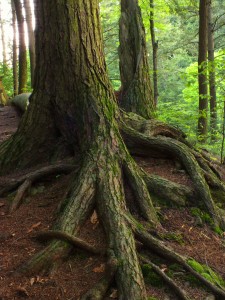by Kristen Minogue
Mysterious things happen to forests as they grow old. The passing of time alters the trees, the animals, the microbes, even how much they breathe.

Hemlock tree in Salt Springs State Park, Penn. Hemlocks are one of the last trees to populate a forest, and those forests seem to be better at storing carbon. (Nicholas_T)
Just like people, forests age. Dense rows of birch and cherry trees give way to tulip poplars. Eventually the tulip poplars vanish and more spacious oaks and hemlocks rise up in their place. But arguably the most important changes occur underground. The planet’s soils store more than three times as much carbon as the atmosphere. And—while researchers still aren’t sure exactly why—older forests seem to be better at holding onto it.
Soils contain 2.5 trillion tons of carbon. That’s more than enough to send Earth’s climate into an upward spiral. Fortunately they’ve developed an arsenal of ways to keep it from escaping into the air. Impenetrable minerals like silt and clay surround some of the decaying material. Other carbon becomes encased in protective microaggregates made of inorganic soil particles. Some clusters have biochemical defenses that make them difficult for microbes to break down.
It’s an ability that appears to grow stronger with age, something Purdue graduate student Yini Ma discovered while working on her Ph.D. dissertation in SERC’s woods with the Plant Ecology Lab.
The reasons aren’t immediately obvious. At first Ma’s preliminary data suggested the exact opposite. Younger forests—the ones in the 60- to 70-year age range—tended to have a greater proportion of physically protected carbon compared to their older counterparts. More carbon latched onto silt or clay or formed microaggregates. Less remained loose and unguarded.Young forests owe much of their carbon storage to a subterranean ally. Earthworms stir up the soil, carrying away carbon at the surface and burying it. They also digest some of the carbon and turn it into tough casts. These casts contain microaggregates bound together with minerals and mucus, making them even harder to break down than before.
And yet all the effort doesn’t seem to be paying off. When Ma took her soil samples back to the lab for testing, preliminary results showed young forests still released more CO2 than the oldest forests in her study, which had been left alone for more than 200 years.
The secret could lie in the type of protection. Physical defenses, the kind younger forests specialize in, may not be the surest way to keep carbon in the ground. More mature forests have some chemical defenses that make their carbon not just difficult but dangerous to digest. Tannins, a type of plant compound often toxic to microbes, may be more common in older forests. Older soils also tend to be more acidic. Younger soils may be much livelier by contrast, thanks to higher nitrogen levels that can boost the activity of carbon-releasing microbes.
Of course the same factors that turn off microbes in old forests may keep earthworms away as well. Earthworms were virtually absent from the oldest forests in Ma’s study. Without worms more carbon collected at the surface, in the first five centimeters of soil. But it seems to be safe there. Old forests don’t need to bury their carbon to protect it—a testament to the power of age and time.
-by Kristen Minogue


